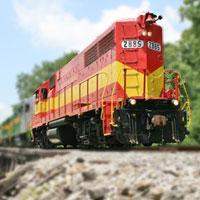 |
Columbus & Greenville Railway Final Day on the Delta Route |
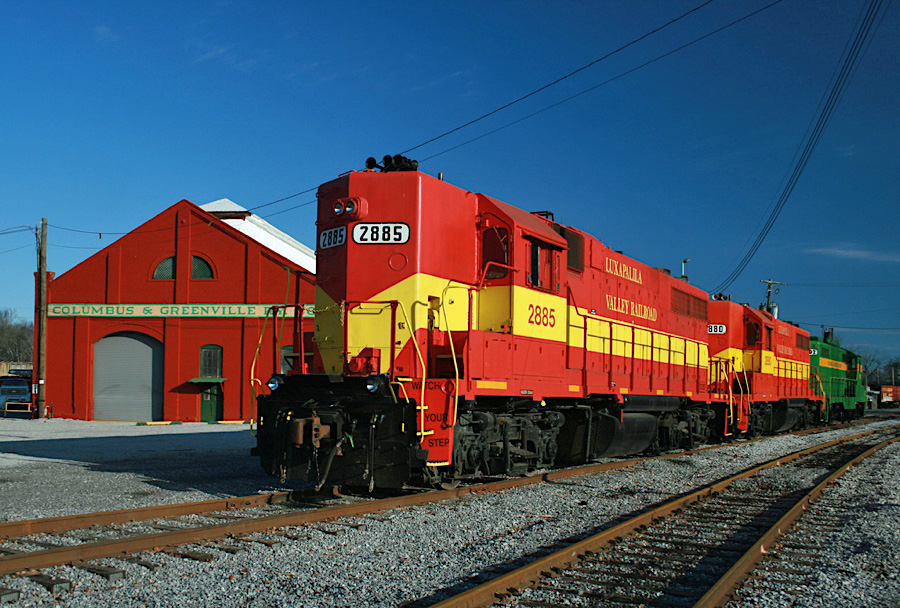
Columbus, Ms / Dec 2008 / Chris Martin
HawkinsRails thanks fellow Delta Route fan Chris Martin for use of his narrative and photos

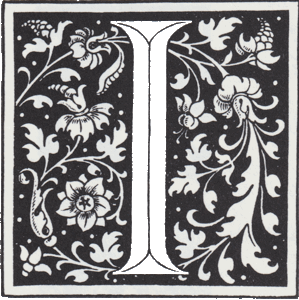 t was in the late 1970's til very early 80's the Columbus & Greenville Railway was transitioning from its grip of a 1972 ICG take over to a newfound independence thanks to a grassroots effort to return it to a private entity. The first decade would be an interesting transition with goals achieved and some set backs. But to the surprise of many the C&G did survive.
t was in the late 1970's til very early 80's the Columbus & Greenville Railway was transitioning from its grip of a 1972 ICG take over to a newfound independence thanks to a grassroots effort to return it to a private entity. The first decade would be an interesting transition with goals achieved and some set backs. But to the surprise of many the C&G did survive.
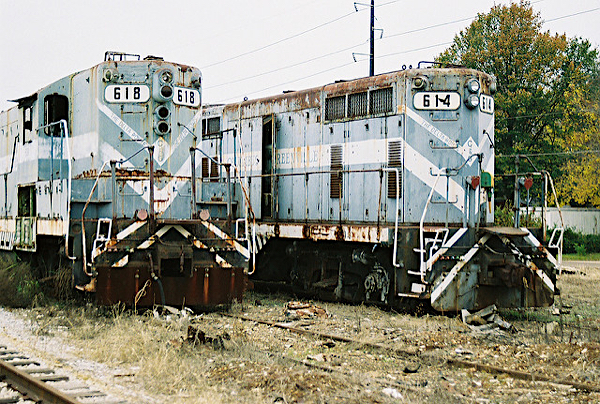 Luckily I got to see some of these transitions. I grew up as a child in north Columbus during this era and my family lived in an apartment near the C&G mainline (before the Waverly bridge closed) and can still remember seeing the old Baldwins and most memorably their replacements, the blue and white ex Florida East Coast 600 class GP7's in their then shiny new paint wobbling up and down the track. This was my introduction to the line with its motto of "Through The Heart Of Dixie."
Luckily I got to see some of these transitions. I grew up as a child in north Columbus during this era and my family lived in an apartment near the C&G mainline (before the Waverly bridge closed) and can still remember seeing the old Baldwins and most memorably their replacements, the blue and white ex Florida East Coast 600 class GP7's in their then shiny new paint wobbling up and down the track. This was my introduction to the line with its motto of "Through The Heart Of Dixie."
It was true delight to see the trains if even through the woods but much to this then young child's dismay we would move but eventually sometime later would locate to the other side of town and lo and behold it was only yards from the C&G main at the south end of the Columbus yard near the MUW college. No longer would trees obstruct my view and I reflect that those were some of the happiest times of my childhood. Mom probably enjoyed that fact that it was free entertainment for me aside from the horn blowing she'd have to endure while watching soap operas. I'm pretty sure the expenses of her buying toys for me declined dramatically.
Railroad wise we were in the middle of everything. Not but a few blocks away were the mainlines of the Burlington Northern, Southern Railway and Illinois Central Gulf but I didn't dare venture off which would result in my moms wrath. While hearing their horns and wondering mystically what they were, moms wrath was an immediate reality which I wouldn't dare challenge even for the wonders of iron beast. So the C&G was all I knew in my younger years.
In many walks to and from school when kids still did such ghastly things, I occasionally encountered the 606 which was still serving as the Columbus switcher. At night my homework would all to often be interrupted as I'd hear the C&G westbound leaving town or building up it's train. Many a night was spent watching the GP7's with their flashing strobe lights giving a roar as they would lug and shove on the tonnage behind them. Sometimes the crews would notice me and give a few toots of the horn.
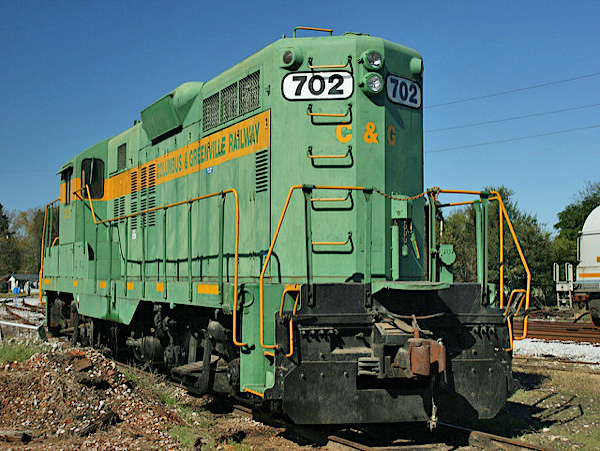 Around this time 4 ex Southern GP9's would show up in March of 1983 taking the 700 series slot once held by the SD28's that ICG made away with. Still yet not far behind the GP9's would it be that the first batch of 10 CF7's classed in the 800 series began to arrive, taking over as the preferred power on road jobs. I recall thinking how weird they looked with their bright Santa Fe colors, boxy cabs and low noses amongst all the high hood units C&G possessed. The switcher jobs in Columbus, West Point, Greenwood, Cleveland and Greenville would inherit a constant rotation of the 600 and 700 classed Geeps for power as the CF7's arrived and the little SW-1's and 606 were stricken from the roster.
Around this time 4 ex Southern GP9's would show up in March of 1983 taking the 700 series slot once held by the SD28's that ICG made away with. Still yet not far behind the GP9's would it be that the first batch of 10 CF7's classed in the 800 series began to arrive, taking over as the preferred power on road jobs. I recall thinking how weird they looked with their bright Santa Fe colors, boxy cabs and low noses amongst all the high hood units C&G possessed. The switcher jobs in Columbus, West Point, Greenwood, Cleveland and Greenville would inherit a constant rotation of the 600 and 700 classed Geeps for power as the CF7's arrived and the little SW-1's and 606 were stricken from the roster.
Of note too are the former C&G 809 and 810. The 809 was sent to another C&G railroad, the Chattooga & Chickamauga RR becoming CCKY 101. Later on it would be sent to yet another C&G operation, the Redmont & Redbay where it still resides today as the RDMNT 101. The C&G 810 was sent to the CCKY in place of the 101 becoming the CCKY 103. It had an electrical fire a few years back and was subsequently scrapped.
In time we would move yet again and I would "lose contact" with the C&G aside from sporadic glimpses and chance meetings that were few and far between. Only luck would allow for that if mom or my oldest sister happened to drive through the old stomping grounds with me in tow. I was never naive enough to dare ask them to carry me out to see trains as this was still back when few cars had air conditioners and though C&G crews were baking in those hot summers, my family wasn't about to for no more than was necessary and certainly not for a "noisy nasty old train."
By the time I was finally reacquainted with the railroad on my own terms, it was still more or less the same though most all the locomotives I'd seen as a child were retired and sat around beaten in faded chalking paint as parts donors or wonderful homes for wasp, mice and the homeless whino. Only the 621, 702, 802, 803, 807 and 808 would survive until the last days of the C&G's independence.
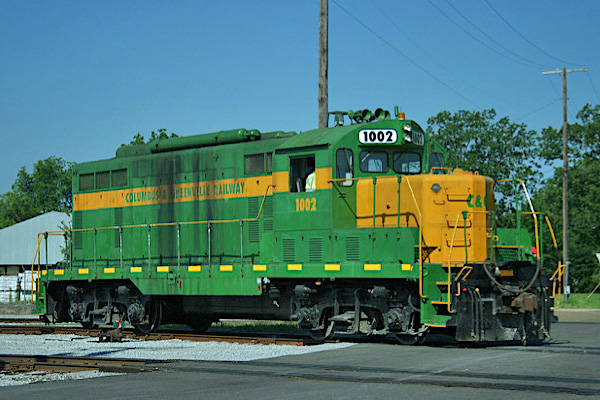 By now, the opening shots began in what would be some of the final purchases by the company motive wise. A handful of former C&NW GP7R's, 5 to be exact, would arrive in 1993. They were put into a 1000 series numbering and were repainted in what would become known as the "John Deere" scheme as the long hoods were painted green and the noses yellow. A yellow stripe ran midway in the height of the long hood with "Columbus & Greenville Railway" in the center of the stripe. Unlike many shortlines, most all C&G units acquired second hand would near immediately receive a new coat of the little railroads current paint scheme. As a side note one of the GP7R's would go to the CCKY and become CCKY 102 where the unit still works as of this writing.
By now, the opening shots began in what would be some of the final purchases by the company motive wise. A handful of former C&NW GP7R's, 5 to be exact, would arrive in 1993. They were put into a 1000 series numbering and were repainted in what would become known as the "John Deere" scheme as the long hoods were painted green and the noses yellow. A yellow stripe ran midway in the height of the long hood with "Columbus & Greenville Railway" in the center of the stripe. Unlike many shortlines, most all C&G units acquired second hand would near immediately receive a new coat of the little railroads current paint scheme. As a side note one of the GP7R's would go to the CCKY and become CCKY 102 where the unit still works as of this writing.
In February 1996 two former Southern Railway GP38's would arrive on the property for preparations of C&G's Luxapalila Valley Railroad. These units had been built for the original Norfolk Southern as low nosed units. However when Southern purchased the NS, all their GP18's and GP38's were rebuilt with Southern's trademark high hood, 2 sets of Nathan horns with 1 set on each end of the hoods and the bells were moved from under the cabs to the top end of the long hood. They were renumbered 2880 and 2885 by Southern and upon their arrival on the C&G they would receive red and yellow paint in a scheme when laid out was reminiscent to that of the old Baldwins.
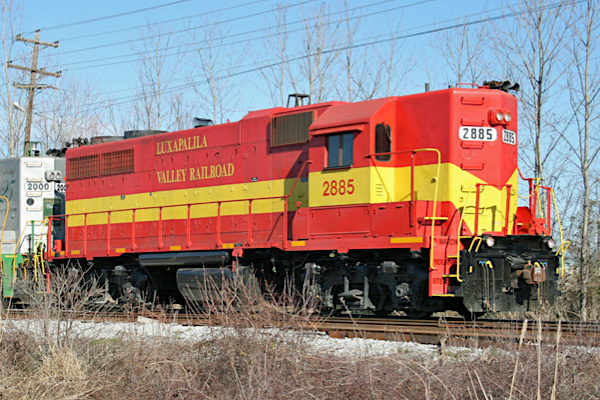 The LXVR or "The Lux" would start operating June 1, 1996 over 38 miles of former Southern Railway trackage from Columbus, MS to Belk, AL purchased from Norfolk Southern. The line from Columbus to the state line had long been owned by the C&G but was exclusively leased to the Southern in 1924 to repay debts owed to that railroad. Southern and the later NS would maintain the leased section of trackage as well as that of their own east of the state line.
The LXVR or "The Lux" would start operating June 1, 1996 over 38 miles of former Southern Railway trackage from Columbus, MS to Belk, AL purchased from Norfolk Southern. The line from Columbus to the state line had long been owned by the C&G but was exclusively leased to the Southern in 1924 to repay debts owed to that railroad. Southern and the later NS would maintain the leased section of trackage as well as that of their own east of the state line.
This was also when C&G discontinued the process of renumbering second hand diesel units they acquired. Now they would retain the numbers assigned by their previous owners with only one upcoming exception.
 C&G was impressed with the Lux GP38's and would purchase 2 more former SOU units from NS when they were retired in April 1997. The 2777 and 2785, equipped with dynamic brakes unlike the 2880 and 2885, traded in their NS black for the John Deere scheme and the LXVR and C&G units intermingled on one another's railroads. In 1999 the 2785 would be renumbered to the C&G 2000 and repainted in a new scheme to commemorate the 25th anniversary of the new railroad's independence from the ICG. The new "Anniversary" scheme was similar to that of the John Deere scheme but the nose, battery boxes and entire cab were painted silver. It would carry the slogan "Celebrating 25 Years Of Service" on both sides of the high short hood and a special decal on the nose with the same slogan while upcoming anniversary scheme units would lack this.
C&G was impressed with the Lux GP38's and would purchase 2 more former SOU units from NS when they were retired in April 1997. The 2777 and 2785, equipped with dynamic brakes unlike the 2880 and 2885, traded in their NS black for the John Deere scheme and the LXVR and C&G units intermingled on one another's railroads. In 1999 the 2785 would be renumbered to the C&G 2000 and repainted in a new scheme to commemorate the 25th anniversary of the new railroad's independence from the ICG. The new "Anniversary" scheme was similar to that of the John Deere scheme but the nose, battery boxes and entire cab were painted silver. It would carry the slogan "Celebrating 25 Years Of Service" on both sides of the high short hood and a special decal on the nose with the same slogan while upcoming anniversary scheme units would lack this.
The arrival of 5 former IC GP11's several years later would prove to be the C&G's final locomotive acquisitions. They would receive the C&G's anniversary scheme. Only the GP11's and the C&G 2000 would be adorned in this scheme. At the time of this writing however one lone GP11, the 1806, still remains in it's former IC black.
The C&G would see many changes in its 33 years as has been described power and paint wise. Some of the other events can be found here on this site and in Louis Saillard's book "The Delta Route."
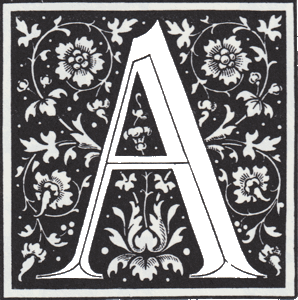 fter viewing Ralph's excellent website again (as I have done many times) on the C&G's history I realized that I had documented the last day of the lines independent operation. Having photographed the C&G so many times between 2003 thru the past few years I tend to forget that sometimes I had done so. Oddly enough I was the only one out that day to witness and document it. Had no one, irregardless of whom, not documented the C&G's last day it would have been a shame at the very minimum. Happily at least that was not the case. I had posted the following images in a Facebook page for the C&G and was quite and still am honored that Ralph inquired about presenting them here. It is here that I feel they have truly found a home and I give Ralph a heartfelt thanks in appreciation for doing so.
fter viewing Ralph's excellent website again (as I have done many times) on the C&G's history I realized that I had documented the last day of the lines independent operation. Having photographed the C&G so many times between 2003 thru the past few years I tend to forget that sometimes I had done so. Oddly enough I was the only one out that day to witness and document it. Had no one, irregardless of whom, not documented the C&G's last day it would have been a shame at the very minimum. Happily at least that was not the case. I had posted the following images in a Facebook page for the C&G and was quite and still am honored that Ralph inquired about presenting them here. It is here that I feel they have truly found a home and I give Ralph a heartfelt thanks in appreciation for doing so.
May 31, 2008
That morning I drove the 115 miles from my home in Birmingham through the predawn hours to arrive in Columbus at day break. It was muggy already at sunrise and had the promisings of being a typical hot sticky Mississippi summer day. After scoping out the roundhouse I drove across town and swung west onto US Highway 82 for Bent Oak.
When I arrived there I found 3 units working the final train. One picture shows all 3 units and each represents the final few schemes the C&G would come to create. The red & yellow unit is the Luxapalila Valley 2885. The 2000 shows the anniversary scheme and lastly the 2777 wears the John Deere scheme that many repainted units would adorn in the mid to late 1990's.
Long time friend Derrick Davis was the engineer along with Caleb Summerford as the conductor. The first four pictures were of them switching the C&G's latest customer, the Sever Corr steel mill at Bent Oak, MS near Artesia. The steel mill would rival C&G's biggest customer, the Delta Western feed mill in Heathman in terms of car loading. For the eastern end of the C&G the new mill was a much needed source of revenue. After taking these four pictures I was going to opt for another vantage point but with it already hot and having shed alot of sweat, the thought of wading through tall Mississippi grass surely heavily laden with chiggers wasn't all that much of a tempting proposition, you just work with what you have to avoid that.
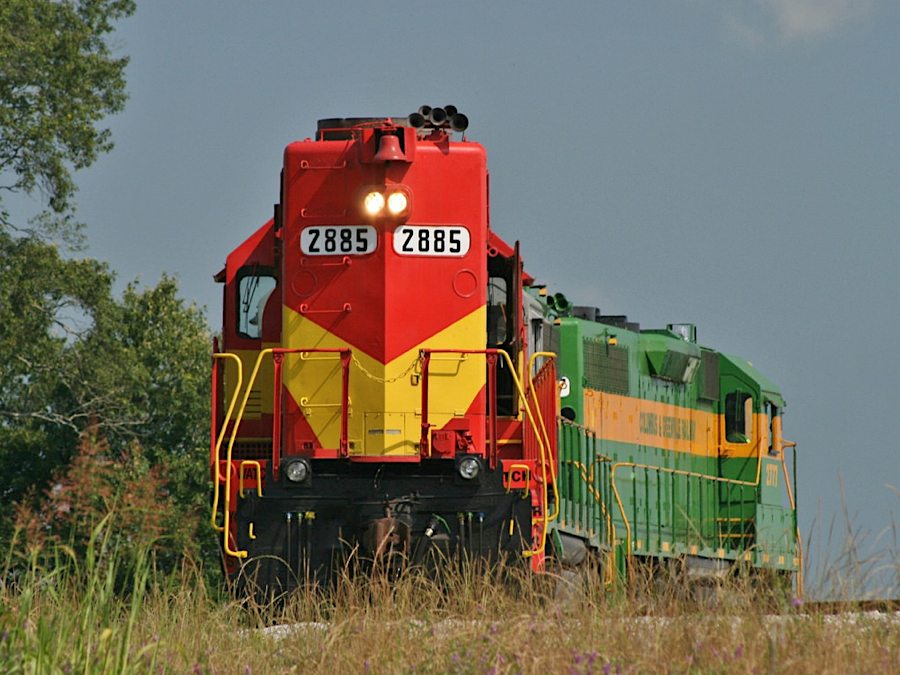


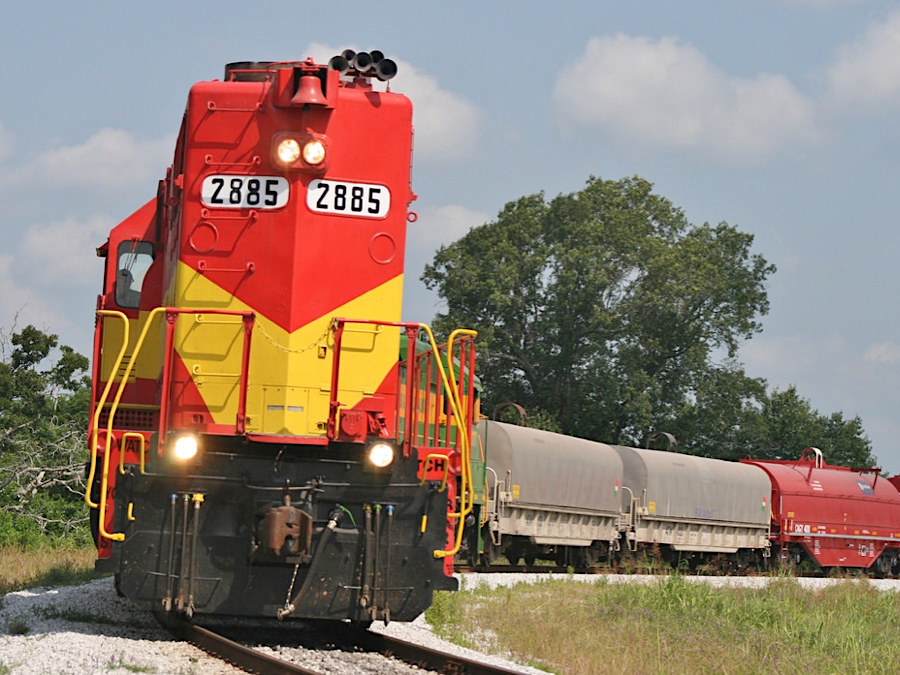
The fifth picture is of the train getting underway heading east back to Columbus. Though Mississippi is generally flat, it does have hills and this view at Bent Oak shows one of the rather stiff grades that they would encounter on their jog up KCS's Tuscaloosa Sub. These rights were put in place as part of the Army Corps Of Engineers ongoing Tennessee Tombigbee Waterway project which would result in closing the old C&G main as a new channel would be dredged that would have to sever the line. Plans were for this to begin in the summer of 1984 but a lose barge striking the Waverly bridge caused them to take place sooner on December 2, 1983 as the barge had struck the bridge the night before causing extensive damage.

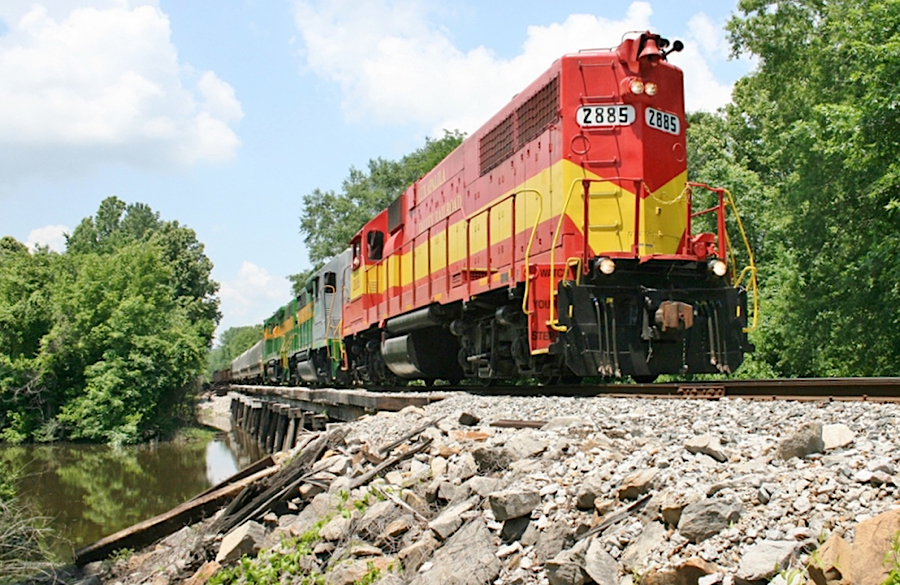
The second picture, above, is at "Go Go Beach" just west of Columbus not far from the banks of the Tombigbee River.
The final view looking south from the roundhouse shows the train back on home rails as it comes into Columbus and drawing a bead on the Main St/US 182 crossing. That was my final image of a train on the still privately held C&G. I was offered a cab ride to carry the train from the depot to the yard just north of town so I wasn't gonna miss that taking pics. It was at 1:10 p.m. that the units were shut down and their hand brakes tied bringing the ending of an era. The C&G wouldn't look any different the next day as the GWI take over became official ... but it would never feel the same.
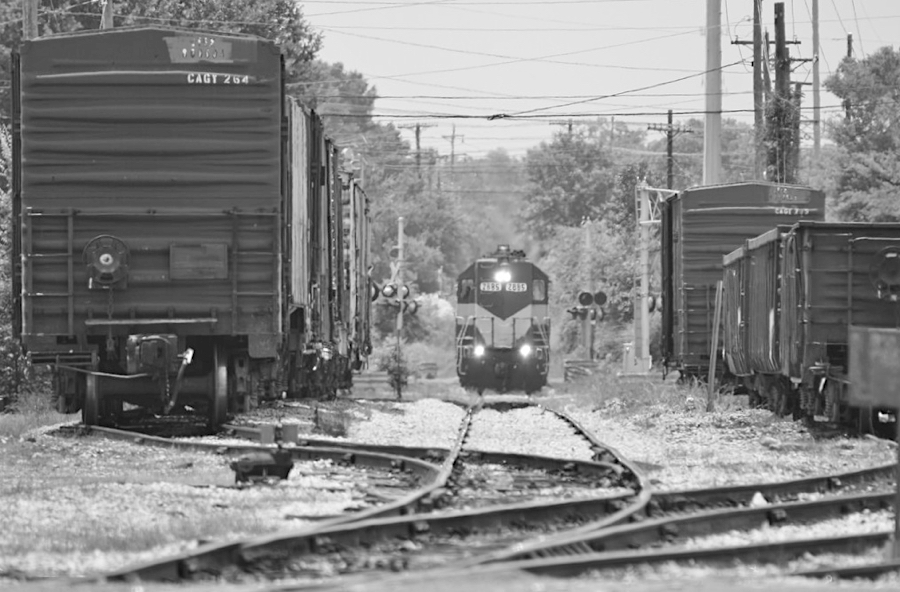
The homespun nature, familiar sights and atmosphere of the railroad however would eventually and quite rapidly fall to the wayside. In short time the offices in Columbus would seat fewer and fewer as their jobs were replaced by others far away in Genesee & Wyoming's "Southeastern Region" office. The only stresses they faced would be an added workload while the now unemployed C&G person had the stresses of losing a good paying job in a small Mississippi town with little to offer.
In that same short time all the few remaining CF7's were retired and sold. The retired units behind the Columbus roundhouse and in the Greenville dead line were promptly scrapped just months into the new owners tenure. A look behind the roundhouse with all the clutter, worn equipment and worn out loco's felt like being on the set of an Ed Wood movie compared to other railroads but it served a purpose, it kept other units going. The 621 was simply stored and had set a few years awaiting a call to duty but GWI had it scrapped despite efforts being underway by preservationist to save it. Both Luxapalila Valley units along with the C&G 702 which took over the Columbus switcher job from the 606 some 25 years before were carted off elsewhere to other GWI railroads. The 702, noteworthy as being the last operational Southern Railway GP9, unfortunately was scrapped a few years into the take over and not sent to a museum.
The LXVR units were both rebuilt which included being returned to their as built low short hood standard and slapped into GWI colors. More and more orange, yellow and black GWI locomotives would show up to take their place and yet more still which would displace more of the remaining familiar old C&G units to other locales far from home.
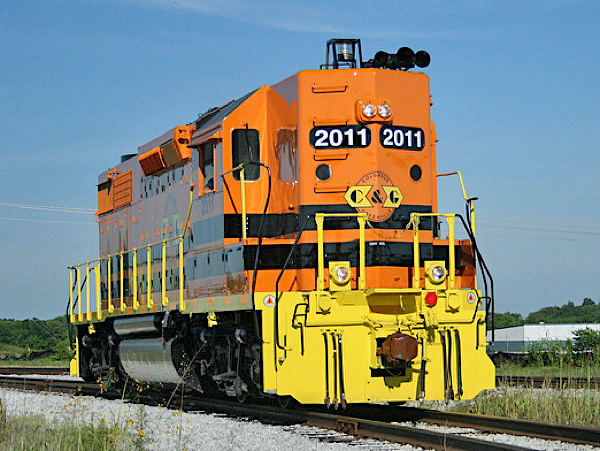 The C&G 2000 in it's flashy anniversary scheme was sent almost immediately straight inside the roundhouse in Columbus. It would emerge as C&G 2011 in GWI colors. The roundhouse ceased doing mechanical work and the shop workers there are no more. If a unit has an ailment either a contractor does the repair or it's sent to GWI's shop in Florida. Also carted off to Florida was the C&G 1948 Buick high railer, never to return.
The C&G 2000 in it's flashy anniversary scheme was sent almost immediately straight inside the roundhouse in Columbus. It would emerge as C&G 2011 in GWI colors. The roundhouse ceased doing mechanical work and the shop workers there are no more. If a unit has an ailment either a contractor does the repair or it's sent to GWI's shop in Florida. Also carted off to Florida was the C&G 1948 Buick high railer, never to return.
The little railroad no longer looked like the lifelong friend I had always known. Things were irrevocably different now. They seemed to change almost at once in rapid fashion with every passing breath. What little remains is just a sad reminder of what once was. Though the atmosphere at the C&G internally may have not been the greatest as no job is perfect, it shined maybe at its brightest until the end.
In closing, I offer a great thanks to the people of the little railroad that ran as it's old slogan stated, "Through The Heart Of Dixie." Your efforts were my and so many others privilege to witness through the brightest of days and deepest of struggles. Thanks for the friendships you created. Thanks for the memories and may they be carried on and not forgotten from here. Thank you.
all narrative and photos above by Chris Martin

See more of Chris Martin's Columbus & Greenville images